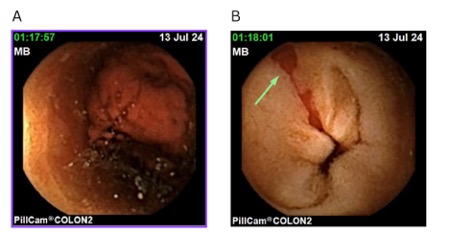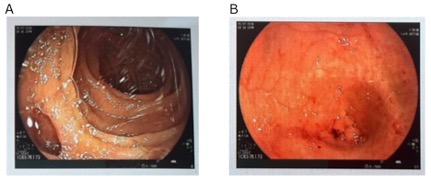Monday Poster Session
Category: GI Bleeding
P3144 - Jejunal Diverticulum with Arteriovenous Malformation Presenting as Obscure GI Bleeding in an Elderly Patient
Monday, October 27, 2025
10:30 AM - 4:00 PM PDT
Location: Exhibit Hall
.jpg)
Adriana Margarita Rey Rubiano, MD (she/her/hers)
Fundacion Santa Fe de Bogota
Bogotá, Distrito Capital de Bogota, Colombia
Presenting Author(s)
Adriana Margarita Rey Rubiano, MD1, Gustavo Adolfo Reyes Medina, MD1, Rafael García-Duperly, MD1, María Paula Mesa Mosquera, MD2, Maria Alejandra Gomez-Gutierrez, MD1, Fernando Sierra-Arango, MD, MSc(Epi)1
1Fundacion Santa Fe de Bogota, Bogotá, Distrito Capital de Bogota, Colombia; 2Independent researcher, Bogotá, Distrito Capital de Bogota, Colombia
Introduction: Small bowel bleeding, defined as hemorrhage occurring between the ampulla of Vater and the ileocecal valve, represents a rare cause of gastrointestinal bleeding, accounting for approximately 5–10% of cases. Diagnosing its source can be challenging, especially in elderly patients with multiple comorbidities, due to the difficulty of localizing the bleeding site using conventional studies. This case describes an unusual presentation of small bowel bleeding due to a jejunal diverticulum associated with an arteriovenous malformation (AVM).
Case Description/
Methods: An 81-year-old male with a history of hypertension, hiatal hernia, gastritis, coronary artery disease, and pandiverticulosis presented with melena, fatigue, weakness, and abdominal pain. Upper endoscopy and total colonoscopy were non-diagnostic. Capsule endoscopy revealed a suspected mass in the proximal jejunum with mucosal erosion and stigmata of bleeding (Figure 1), which was later interpreted as an inverted bleeding diverticulum based on surgical findings. Magnetic resonance enterography and antegrade enteroscopy were inconclusive. Due to clinical deterioration, the patient underwent diagnostic laparoscopy with intraoperative enteroscopy. This revealed multiple broad-based jejunal diverticula; one contained visible content, superficial mucosal erosions, and stigmata of recent bleeding (Figure 2A–B). An AVM was identified and surgically resected. Histopathology confirmed pseudodiverticula with mucosal erosion and an AVM. The patient had an uneventful recovery.
Discussion: This case illustrates a rare cause of small bowel bleeding due to the coexistence of a jejunal diverticulum and an arteriovenous malformation. Among the eight similar cases reported, this case is notable for the use of a multi-modal diagnostic approach, including capsule endoscopy, magnetic resonance enterography, and surgical exploration. It emphasizes the importance of maintaining a high index of suspicion for rare etiologies in complex cases. The coexistence of diverticula and arteriovenous malformations is exceptionally rare. Even with advanced diagnostic tools, surgical intervention may be necessary for definitive management. This demonstrates the importance of a systematic diagnostic approach in elderly patients with unexplained gastrointestinal bleeding.

Figure: Image 1. Video capsule endoscopy showing a suspected mass in the proximal jejunum.

Figure: Image 2. Intraoperative enteroscopy findings. A. Broad-necked jejunal diverticulum. B. Diverticular lumen with visible content and stigmata of recent bleeding.
Disclosures:
Adriana Margarita Rey Rubiano indicated no relevant financial relationships.
Gustavo Adolfo Reyes Medina indicated no relevant financial relationships.
Rafael García-Duperly indicated no relevant financial relationships.
María Paula Mesa Mosquera indicated no relevant financial relationships.
Maria Alejandra Gomez-Gutierrez indicated no relevant financial relationships.
Fernando Sierra-Arango indicated no relevant financial relationships.
Adriana Margarita Rey Rubiano, MD1, Gustavo Adolfo Reyes Medina, MD1, Rafael García-Duperly, MD1, María Paula Mesa Mosquera, MD2, Maria Alejandra Gomez-Gutierrez, MD1, Fernando Sierra-Arango, MD, MSc(Epi)1. P3144 - Jejunal Diverticulum with Arteriovenous Malformation Presenting as Obscure GI Bleeding in an Elderly Patient, ACG 2025 Annual Scientific Meeting Abstracts. Phoenix, AZ: American College of Gastroenterology.
1Fundacion Santa Fe de Bogota, Bogotá, Distrito Capital de Bogota, Colombia; 2Independent researcher, Bogotá, Distrito Capital de Bogota, Colombia
Introduction: Small bowel bleeding, defined as hemorrhage occurring between the ampulla of Vater and the ileocecal valve, represents a rare cause of gastrointestinal bleeding, accounting for approximately 5–10% of cases. Diagnosing its source can be challenging, especially in elderly patients with multiple comorbidities, due to the difficulty of localizing the bleeding site using conventional studies. This case describes an unusual presentation of small bowel bleeding due to a jejunal diverticulum associated with an arteriovenous malformation (AVM).
Case Description/
Methods: An 81-year-old male with a history of hypertension, hiatal hernia, gastritis, coronary artery disease, and pandiverticulosis presented with melena, fatigue, weakness, and abdominal pain. Upper endoscopy and total colonoscopy were non-diagnostic. Capsule endoscopy revealed a suspected mass in the proximal jejunum with mucosal erosion and stigmata of bleeding (Figure 1), which was later interpreted as an inverted bleeding diverticulum based on surgical findings. Magnetic resonance enterography and antegrade enteroscopy were inconclusive. Due to clinical deterioration, the patient underwent diagnostic laparoscopy with intraoperative enteroscopy. This revealed multiple broad-based jejunal diverticula; one contained visible content, superficial mucosal erosions, and stigmata of recent bleeding (Figure 2A–B). An AVM was identified and surgically resected. Histopathology confirmed pseudodiverticula with mucosal erosion and an AVM. The patient had an uneventful recovery.
Discussion: This case illustrates a rare cause of small bowel bleeding due to the coexistence of a jejunal diverticulum and an arteriovenous malformation. Among the eight similar cases reported, this case is notable for the use of a multi-modal diagnostic approach, including capsule endoscopy, magnetic resonance enterography, and surgical exploration. It emphasizes the importance of maintaining a high index of suspicion for rare etiologies in complex cases. The coexistence of diverticula and arteriovenous malformations is exceptionally rare. Even with advanced diagnostic tools, surgical intervention may be necessary for definitive management. This demonstrates the importance of a systematic diagnostic approach in elderly patients with unexplained gastrointestinal bleeding.

Figure: Image 1. Video capsule endoscopy showing a suspected mass in the proximal jejunum.

Figure: Image 2. Intraoperative enteroscopy findings. A. Broad-necked jejunal diverticulum. B. Diverticular lumen with visible content and stigmata of recent bleeding.
Disclosures:
Adriana Margarita Rey Rubiano indicated no relevant financial relationships.
Gustavo Adolfo Reyes Medina indicated no relevant financial relationships.
Rafael García-Duperly indicated no relevant financial relationships.
María Paula Mesa Mosquera indicated no relevant financial relationships.
Maria Alejandra Gomez-Gutierrez indicated no relevant financial relationships.
Fernando Sierra-Arango indicated no relevant financial relationships.
Adriana Margarita Rey Rubiano, MD1, Gustavo Adolfo Reyes Medina, MD1, Rafael García-Duperly, MD1, María Paula Mesa Mosquera, MD2, Maria Alejandra Gomez-Gutierrez, MD1, Fernando Sierra-Arango, MD, MSc(Epi)1. P3144 - Jejunal Diverticulum with Arteriovenous Malformation Presenting as Obscure GI Bleeding in an Elderly Patient, ACG 2025 Annual Scientific Meeting Abstracts. Phoenix, AZ: American College of Gastroenterology.

